The Top 50+ Employee Engagement Statistics You Need to Bookmark
The pandemic has significantly changed employees' perspectives on how they want to interact with their employers. Faced with a shifting work culture, companies are challenged to find ways to boost employee engagement.
What has worked so far, and what hasn't? How is the shift affecting both employers and employees? The employee engagement statistics below will give you the state of employee engagement and how companies can adapt to it.
Are Employees Really Engaged?
If you answered yes to the question in the heading, the data might surprise you.
Research shows that only 36% of workers say they are enthusiastic about their jobs, while a staggering 85% of people are disengaged employees.

What's more, 14% say that they are actively disengaged at work.
On the other hand, the employee engagement levels are quite devastating. Only 36% of people say they are engaged in the workplace, and only 10% come from the western hemisphere.
Across all industries, Office, Sales, and Construction suffer the worst, with only a 12% engagement rate among their employees.
 While this should raise alarm, companies that use tools like our Microsoft Teams integration and other collaborative software can improve engagement.
While this should raise alarm, companies that use tools like our Microsoft Teams integration and other collaborative software can improve engagement.
Though why is an engaged workforce so important for your company?
What Is the Cost of Employee Disengagement Within Organizations?
First, employee disengagement often leads to higher employee churn.
Over 81% of employees confirm that leaving their job is an option if given the right offer.
Considering that a company spends an average of $5,000 on hiring a new person, having disengaged workers can hit your bottom line in many ways, and these expenses can add up very quickly.
Every year, companies in the U.S. spend $1.1 billion to find replacement employees.
 Additionally, employee disengagement often leads to lost productivity.
Additionally, employee disengagement often leads to lost productivity.
Some estimations show that a company spends 34% of the employee's salary on lost productivity. Others show that this cost in the U.S. is between $450 billion to $550 billion each year. But what causes employees to disengage?
What Makes Disengaged Employees?
There are several factors that make employees disengaged, including:
-
Boredom
-
Minimal diversity and inclusion
-
Poor managers
Boredom is one of the key reasons why employees become disengaged. Case in point, one study showed that up to one-third of employees say they are often bored at their workplace.
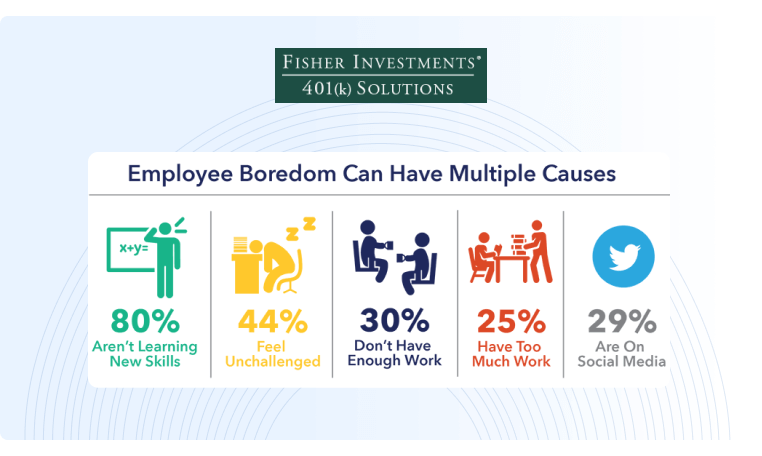 Source: Fisher401k
Source: Fisher401k
To avoid boredom, give your employees ownership of their work and ask them to develop solutions for challenges the department is facing. If you're currently treating your employees like robots to perform various tasks, they won't feel significant, leading to demotivation and disengagement.
Another key reason that employees become disengaged is minimal diversity and inclusion.
One study that analyzed diverse teams in a corporate environment found they outperformed individual decision-makers 87% of the time.
If employees don't feel that they fit in with their co-workers, they are less likely to engage and there's a good chance that they will eventually churn and leave the company. In fact, a study by Deloitte found that about 39% of employees would leave their job if they were offered a job at a more diverse company, and when surveying only millennials, that statistic rose to 53%.
Another factor that greatly impacts an employee’s engagement is his/her manager.
One recent study showed that 75% of employees claim to ultimately leave a job because of the manager rather than the company itself. To solve this, ensure managers are asking for feedback regularly. Another study showed that only about 21% of employers ask for feedback, so start by simply asking employers to collect feedback and take action on the most pressing issues.
Managerial issues also tend to be a symptom of cultural issues, which is equally worrying. Recruitment and career coaching specialist, Robert Walter, found that almost 73% of professionals leave their work if the office culture is not the right fit for them.
Even worse, 67% of people in the same study said that they had been misled about the company culture during the induction process.
 Therefore, revisit your core values and regularly collect feedback to ensure your company’s culture is strong across all teams.
Therefore, revisit your core values and regularly collect feedback to ensure your company’s culture is strong across all teams.
What Impact Did the Pandemic Have on the Global Workforce?
One of the hottest topics of today's business world is the pandemic and how it has affected employee engagement.
Employers who went the extra mile to keep their workers engaged were able to thrive in this new world – while those who couldn't, suffered.
Gartner's research shows that 88% of organizations either recommended or mandated that their employees work from home. Meanwhile, only 60% of employers worked on employee happiness after making the transition.
Additionally, very few companies had a concrete employee engagement strategy that efficiently prepared the team to work from home. The same research shows that only 31% had employee surveys, while 13% had focus groups.
Unfortunately, this meant only 47% of companies were able to meet the crisis with the best possible outcome based on their capacities or processes already installed.
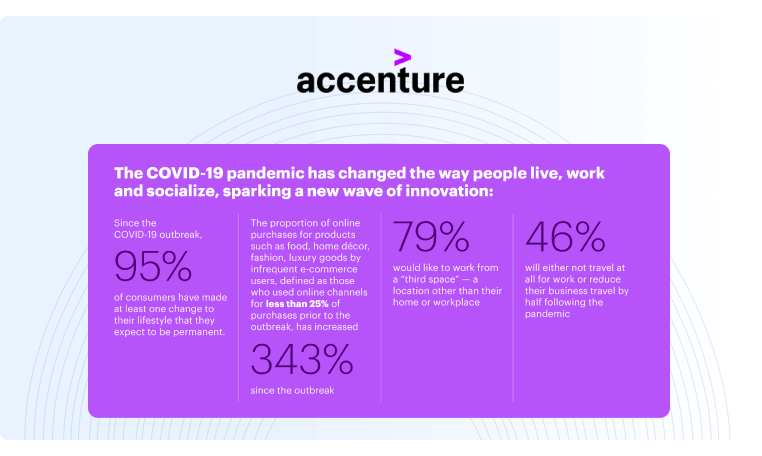 Source: Accenture
Source: Accenture
On the bright side, Statistica ran a survey in the UK and found that 73% of people said they are more effective when working from home.
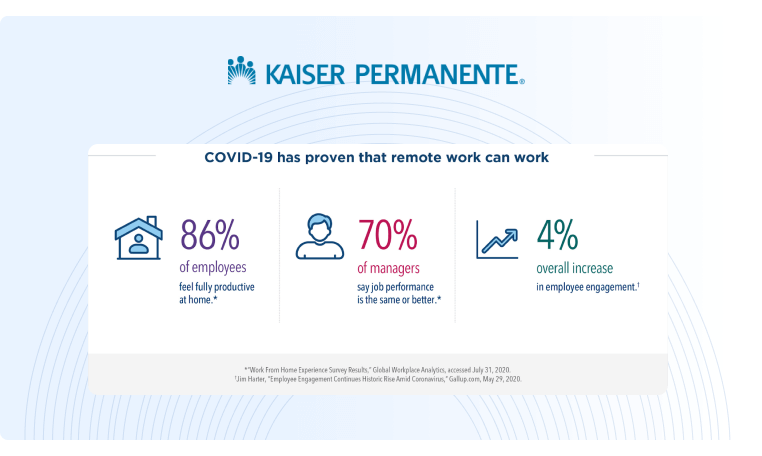 Source: Kaiser Permanente
Source: Kaiser Permanente
About 47% of respondents said they appreciated that they no longer needed to commute, while 43% of respondents said they loved having a more flexible.
The downside is that 22% of the employees have trouble disconnecting from work after their workday is done. Meanwhile, Forbes found that nearly half of all people felt moderately or very drained after video calls.
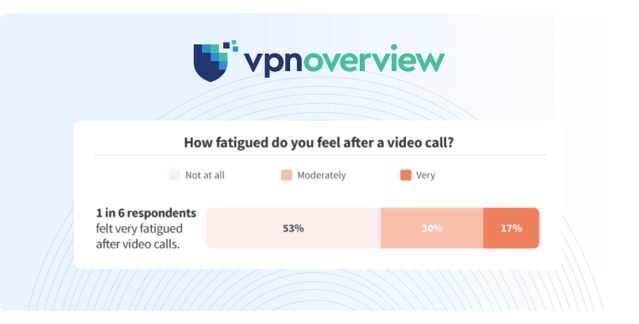 Source: VPN Overview
Source: VPN Overview
Corporate culture suffered as well.
75% of people feel more socially isolated, 57% suffer from anxiety even more than usual, while 53% said they are emotionally exhausted. Forbes discovered that 20% of employees also lack a sense of belonging – and that they are often lonely.
As you can notice, many people did not feel like they got the support they needed.
 Perceptyx found that just 42% of employees felt that their employers effectively led the company through the crisis.
Perceptyx found that just 42% of employees felt that their employers effectively led the company through the crisis.
Employees who believe this say they are 23% more likely to have a decline in their mental health.
Many employees also overextend themselves, with a study from Cityam revealing that 86% of employees feel overextended to prove themselves to their bosses.
 To help employees feel less stressed, consider conducting weekly or bi-weekly pulse meetings with leadership to discuss growth and overall happiness.
To help employees feel less stressed, consider conducting weekly or bi-weekly pulse meetings with leadership to discuss growth and overall happiness.
In fact, the Harvard Business Review found that more than 90% of employees prefer to have weekly conversations with their leadership to alleviate their stress.
Another study by Trade Press Services found that 85% of people feel more engaged at work when internal communication is effective.
What Is the State of Employee Retention?
Companies find it significantly more difficult to retain talent, with 63.3% saying that employee retention is even more challenging than finding the right employee.
 A Columbia University study shows that the likelihood of job turnover in an organization with a good corporate culture is only 13.9%, while the likelihood of job turnover in a terrible corporate culture is 48.4%.
A Columbia University study shows that the likelihood of job turnover in an organization with a good corporate culture is only 13.9%, while the likelihood of job turnover in a terrible corporate culture is 48.4%.
In addition, only 37% of employees that work at companies that prioritize culture actively look for new jobs. In contrast, out of 73% of disengaged employees, 56% are actively seeking a new role.
About 74% of people say that they would gladly earn less money if it meant switching to a job with better culture and more career advancement opportunities.
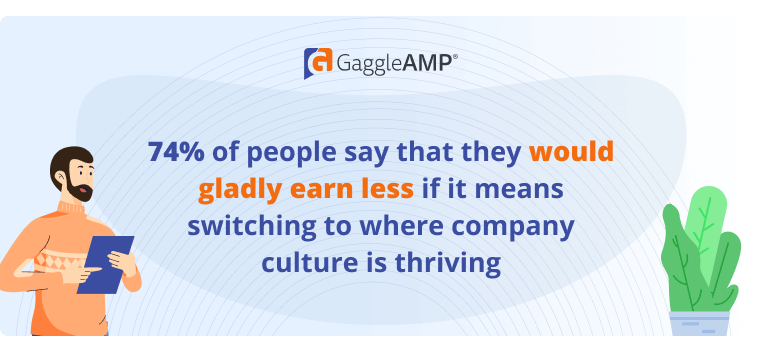 Another factor that can significantly impact employee happiness and retention is their relationship with their boss.
Another factor that can significantly impact employee happiness and retention is their relationship with their boss.
About 37% of people say employee recognition significantly boosts their productivity, while 75% of the people who quit their job did so because of tension with their boss.
Additionally, 96% of people say that empathy is one of the main factors of employee retention.
So be sure to foster empathy and constantly evaluate company culture even when working remotely.
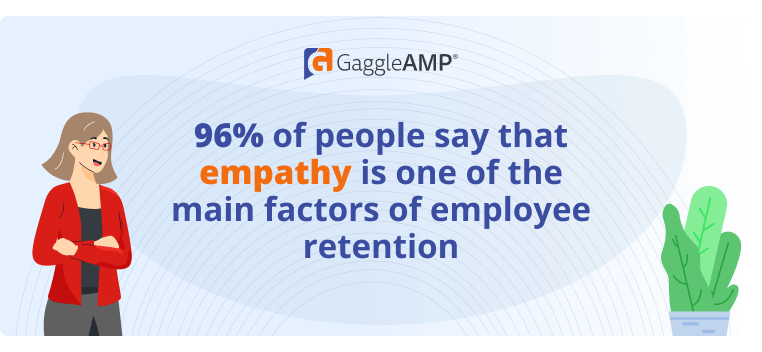
How Does Employee Engagement Benefit Companies?
Engaged employees contribute to:
-
Increasing the company's profitability.
-
Improving the overall productivity of the company.
-
Achieving the company's objectives faster.
-
Providing a better experience to the company's customers.
For example, if approximately 60% of your workforce is engaged, your company will likely enjoy an 11% increase in profits. Meanwhile, companies with a highly engaged workforce tend to enjoy 23% higher profits than the industry average.
Also, companies with engaged employees score a 60% reduction in turnover.
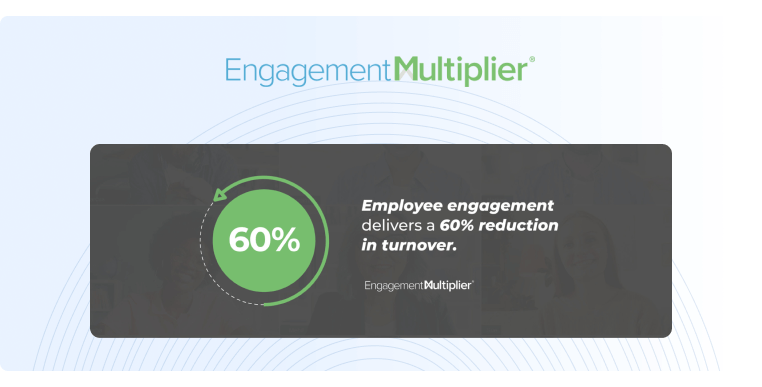 Source: Engagement Multiplier
Source: Engagement Multiplier
Given that hiring a new employee costs significantly more than retaining one, invest in more employee engagement activities, as it will pay dividends in the long run.
How to Motivate Your Teams And Improve Employee Engagement?
Data shows that the best way to motivate your employees is by:
-
Choose the best channel to communicate with them. (Hint: video calls are often not the way to go).
-
Offering better career opportunities and promotions.
-
Designing workplaces that make them feel good.
Let’s dive into each one in detail.
Choose The Best Channel to Communicate With Employees
About 73% of people think they are more effective working from home, though as many as 38% feel exhausted from daily online meetings.

Source: Oak
Today, companies can communicate asynchronously through Slack and Loom, so test these alternative communication methods and measure how they impact employee engagement.
In addition, evaluate how many team meetings you’re currently conducting and how many of them are really necessary. Many of them can probably be replaced with a quick audio message or Slack update. If nothing else, limit them to 15 minutes or less.
Offer Better Career Opportunities
Another way to motivate your employees is to give them the recognition they deserve. Studies have shown that employee recognition is a major motivator for 37% of the workforce.
Similarly, offering your employees exceptional career development opportunities boosts their engagement. For instance, only 29% of the workforce says they are satisfied with how they can advance, while 33% leave their position in search of new challenges.
 Design Workplaces Employees Feel Comfortable In
Design Workplaces Employees Feel Comfortable In
Finally, get input from your employees before designing the workplace. Statistics show that 70% of American workplaces shape up their offices to have an open plan – giants like Facebook and Google included. This is because workers who can move around are 1.3 times more engaged, while this goes up to 1.5 times when employees can connect with coworkers.
 This doesn’t apply to everybody, though. About 42% of workers did say they would leave for a job that offers more privacy, while 33% would do the same for an office with a door. Therefore, listen to your employees and renovate the office factoring to their liking.
This doesn’t apply to everybody, though. About 42% of workers did say they would leave for a job that offers more privacy, while 33% would do the same for an office with a door. Therefore, listen to your employees and renovate the office factoring to their liking.
If you’re currently operating as a hybrid or remote team, encourage employees to create spaces within their homes that they enjoy working in.
Grow Your Business by Boosting Employee Engagement And Advocacy
If you’re struggling to improve internal communication in your company, consider implementing an employee advocacy program. This helps employees stay informed on current company events and removes the communication barrier to stimulate employee engagement.
If you need an employee advocacy program, consider GaggleAMP. We offer in-depth analytics, dashboards, and benchmarking against other programs. Plus, our platform gives you the ability to measure clicks, shares, and engagements to track the performance against your KPIs and outcomes.
See GaggleAMP for yourself by signing up for a free trial today.










